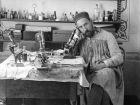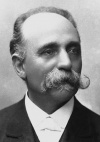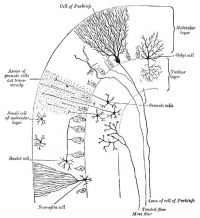Template:Cerebellum Vignette: Difference between revisions
From Embryology
mNo edit summary |
mNo edit summary |
||
| Line 2: | Line 2: | ||
|+ [[Historic Embryology Vignette|'''Historic Embryology''']] | |+ [[Historic Embryology Vignette|'''Historic Embryology''']] | ||
|-bgcolor="FAF5FF" | |-bgcolor="FAF5FF" | ||
| [[File:Santiago Ramon y Cahal in laboratory.jpg|140px|left]] Much of the basic structure of the {{cerebellum}} comes the historic histological studies and staining of [[Embryology_History_-_Santiago_Ramón_y_Cajal|Ramón Cahal (1852 - 1934)]] and Camillo Golgi (1843 - 1926). [[Embryology History - Santiago Ramón y Cajal|Cahal]] was a Spanish researcher who used the then new histology [[Histology_Stains#Golgi_Method|Golgi staining techniques]] to identify the cerebellum cellular structure. His work was a turning point in our understanding of the structure of the brain, that until then had been described as a "syncytium" and not consisting of discrete cellular elements. For this research and other work on defining the structure of the brain he, along with Camillo Golgi (1843 - 1926), received the 1906 Nobel Prize in Medicine. | | [[File:Santiago Ramon y Cahal in laboratory.jpg|140px|left|alt=Santiago Ramón y Cajal|link=Embryology History - Santiago Ramón y Cajal]] Much of the basic structure of the {{cerebellum}} comes the historic histological studies and staining of [[Embryology_History_-_Santiago_Ramón_y_Cajal|Ramón Cahal (1852 - 1934)]] and Camillo Golgi (1843 - 1926). [[Embryology History - Santiago Ramón y Cajal|Cahal]] was a Spanish researcher who used the then new histology [[Histology_Stains#Golgi_Method|Golgi staining techniques]] to identify the cerebellum cellular structure. His work was a turning point in our understanding of the structure of the brain, that until then had been described as a "syncytium" and not consisting of discrete cellular elements. For this research and other work on defining the structure of the brain he, along with Camillo Golgi (1843 - 1926), received the 1906 Nobel Prize in Medicine. | ||
{| class="wikitable mw-collapsible mw-collapsed" | {| class="wikitable mw-collapsible mw-collapsed" | ||
! colspan=2|Camillo Golgi | ! colspan=2|Camillo Golgi | ||
Revision as of 15:52, 18 June 2019
Much of the basic structure of the cerebellum comes the historic histological studies and staining of Ramón Cahal (1852 - 1934) and Camillo Golgi (1843 - 1926). Cahal was a Spanish researcher who used the then new histology Golgi staining techniques to identify the cerebellum cellular structure. His work was a turning point in our understanding of the structure of the brain, that until then had been described as a "syncytium" and not consisting of discrete cellular elements. For this research and other work on defining the structure of the brain he, along with Camillo Golgi (1843 - 1926), received the 1906 Nobel Prize in Medicine.
| ||||


